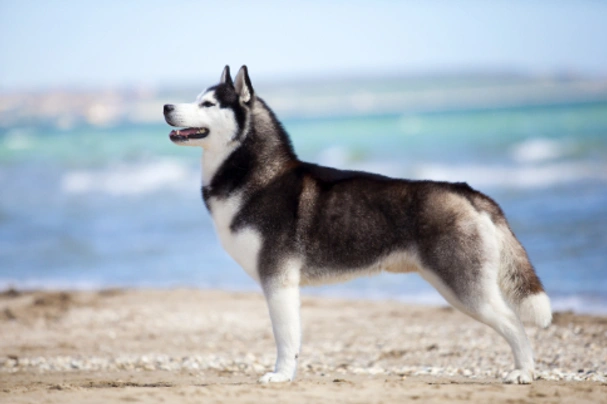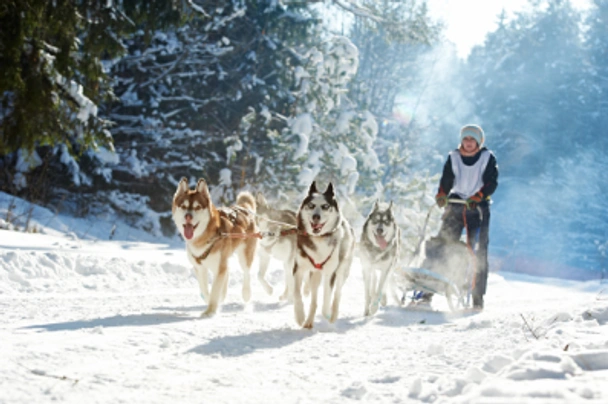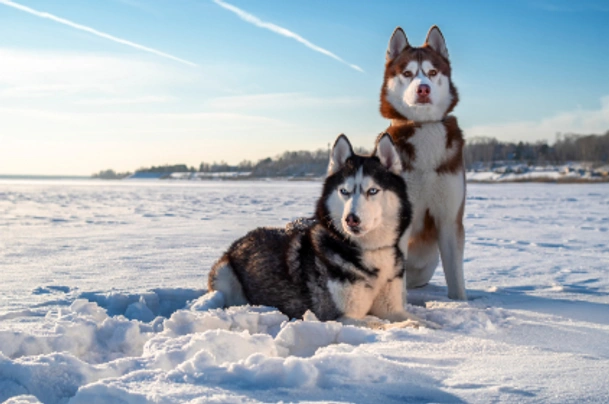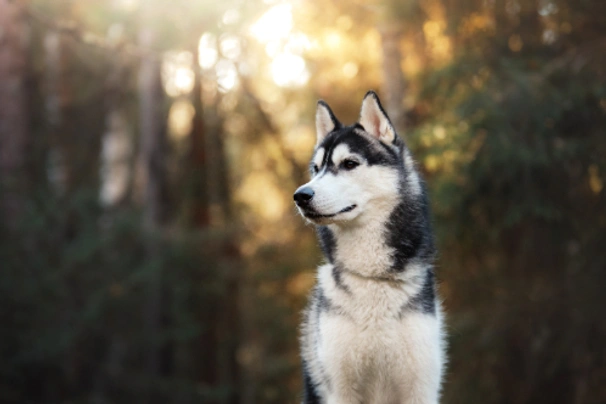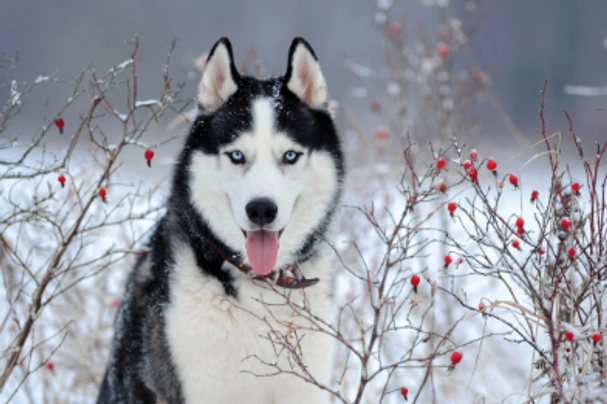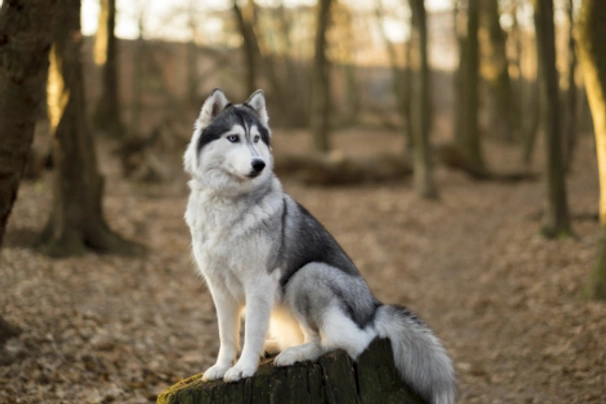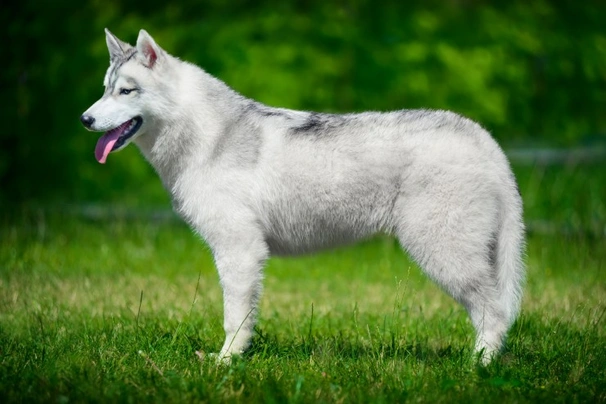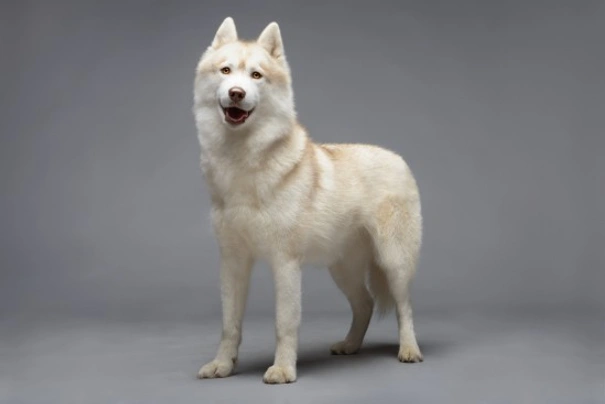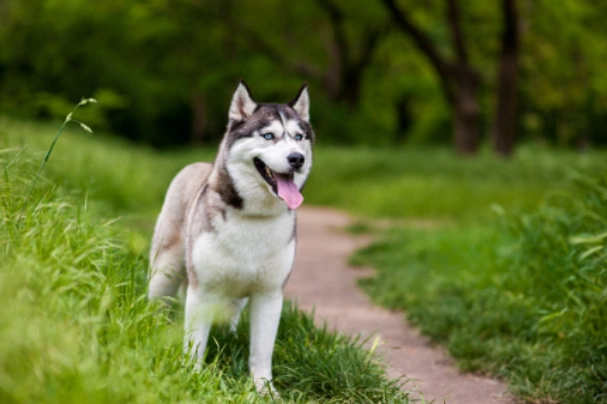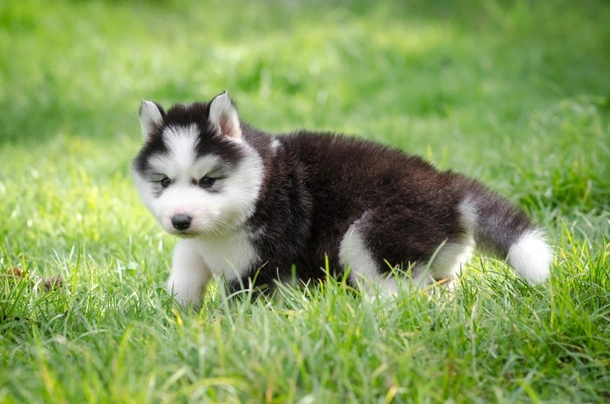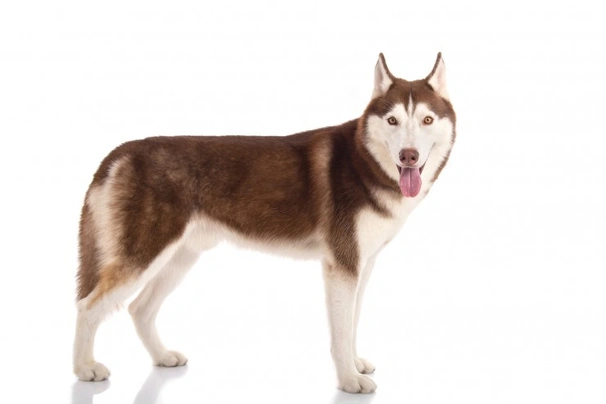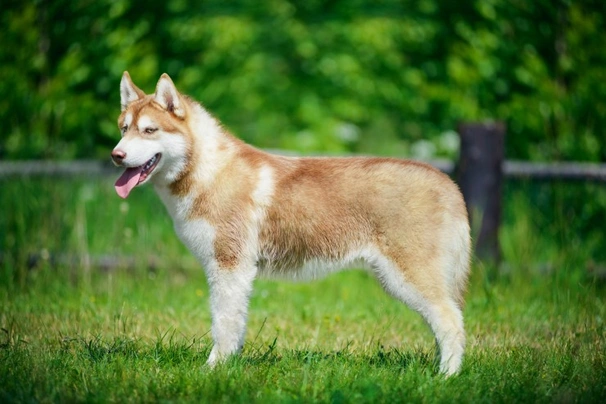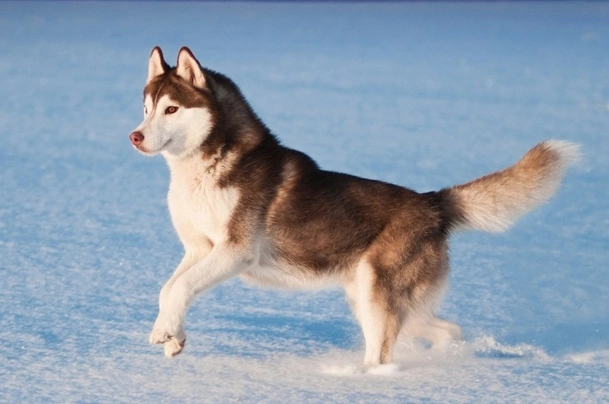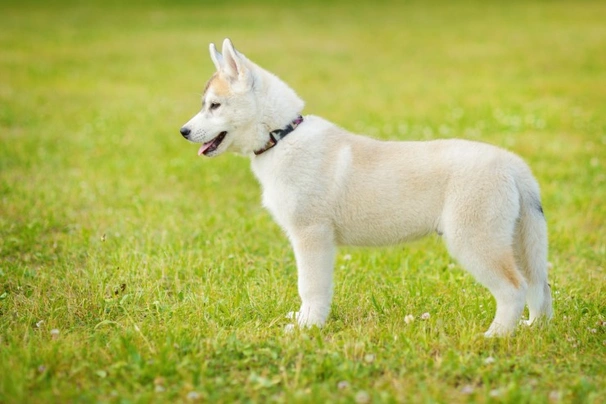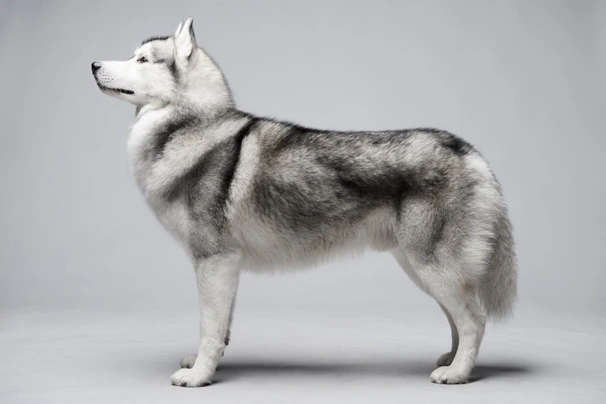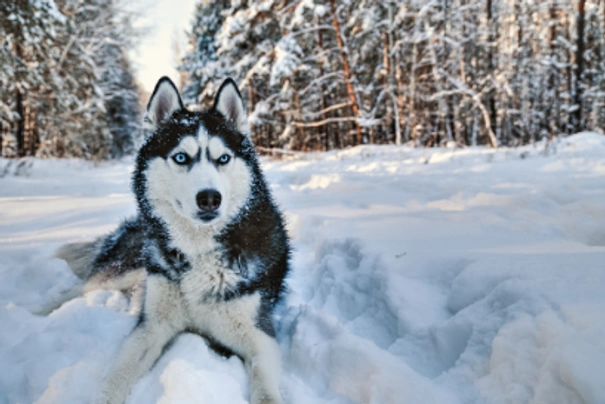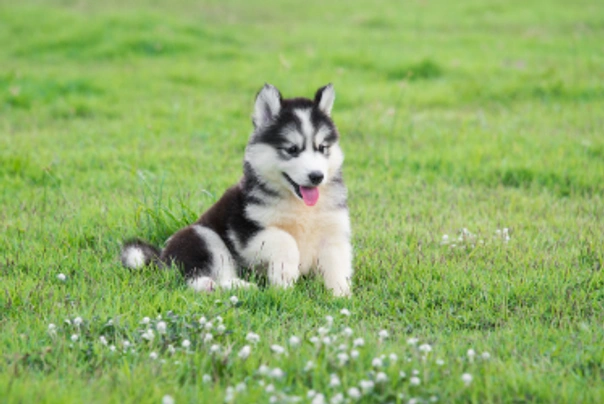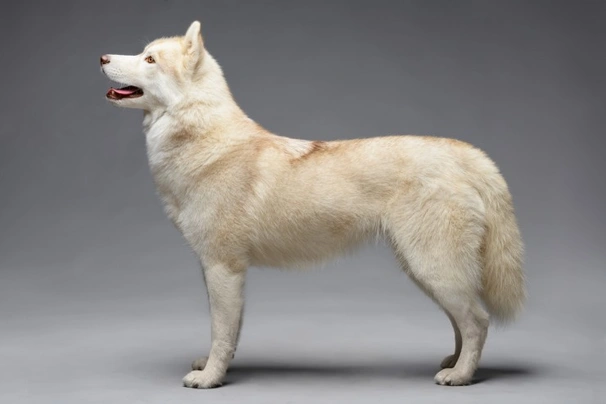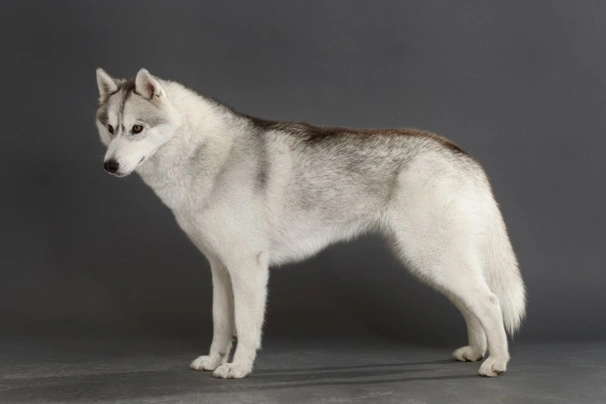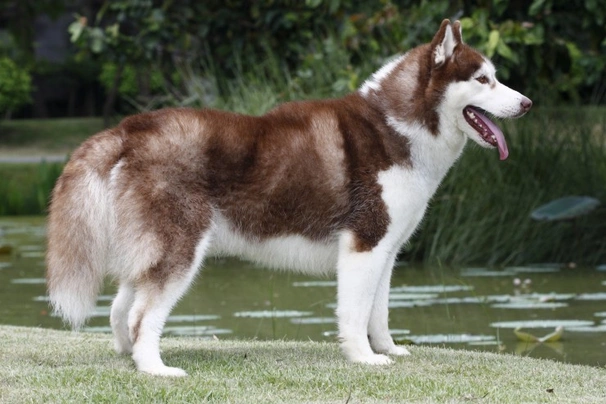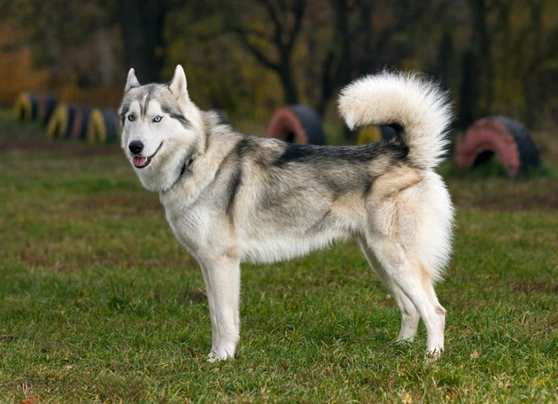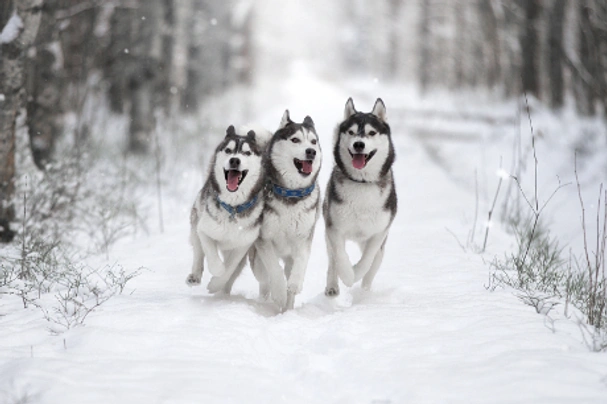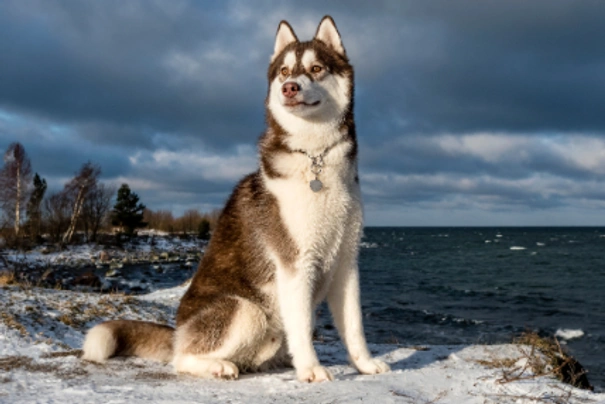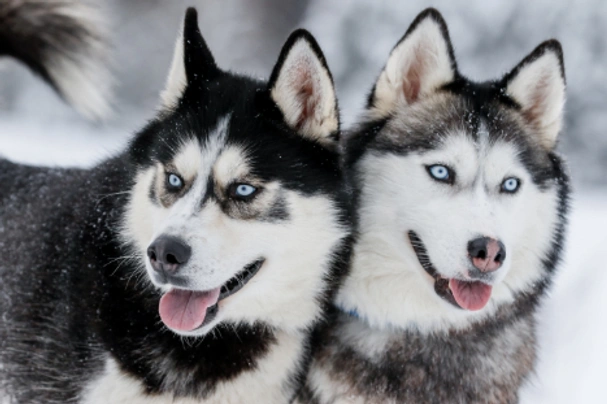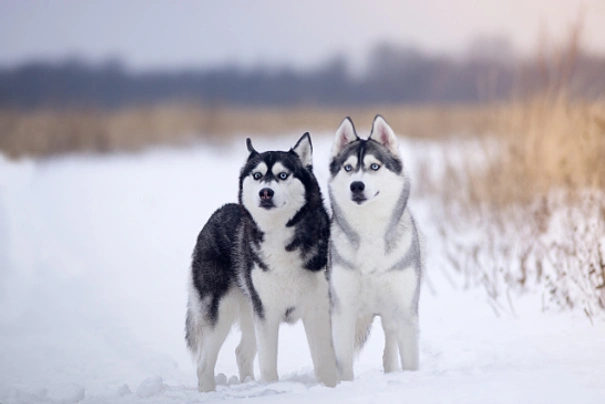Siberian Husky
Pros
Cons
Introduction of the Siberian Husky
The Siberian Husky as their name suggests originates from Eastern Siberia where they were used as sleigh dogs by the Chukchi. Known for their tremendous stamina and good looks the Siberian Husky is a very popular choice both as a family pet and companion dog. They are athletic alert and enjoy being around other Huskies rather than being on their own. The Siberian Husky is not the best choice for first time owners but in the right hands and living with people who are familiar with the breed and therefore known how to train and handle them they thrive in a home environment making them a good choice as a family pet.
History of the Siberian Husky
During the 19th century the Chukchis used the Siberian Husky as sleigh dogs and they treated them extremely well with both man and dog living alongside each other in complete harmony. They depended on one another to survive in what is often extremely harsh conditions. Siberian Huskies were first seen in Alaska early in the 20th century and at that time they were still called Chuckchis. Because these dogs proved themselves to be incredibly fast at sled racing which was a very popular sport during this period of time Siberian Huskies were soon to taken to compete in the States where they were renamed "Siberian Huskies".
Huskies are known to be one of the oldest known breeds on the planet and over time the breed has not changed from the dogs seen way back in the 19th century. Today the Siberian Husky has become a popular choice as family pets and companion dogs both here in the UK and elsewhere in the world thanks to their lovely looks affectionate and loyal natures.
Interesting facts about the breed
- Are Siberian Huskies a vulnerable breed? No they are one of the most popular dogs not only in the UK but elsewhere in the world too.
- Siberian Huskies first arrived in Alaska during the Nome Gold Rush
- Siberian Huskies are highly skilled escape artists
- There's a bronze statue erected in Central Park dedicated to a Siberian Husky called Balto a dog that led a team of Huskies carrying medicine to people in Nome Alaska during a diphtheria outbreak
Appearance of the Siberian Husky
Height at the withers: Males 53 - 61 cm Females 51 - 56 cm at the withers
Average weight: Males 20 - 27 kg Females 16 - 23 kg
The Siberian Husky is a very attractive dog that’s known for their wolf-like looks. They are a medium size dog that boasts being very light on their feet with the males being slightly heavier than their female counterparts. Their heads are nicely proportioned in relation to the rest of the bodies being finely chiseled. Their skull is slightly domed and their muzzles are moderately long and wide tapering to the nose. Their stops are well defined and noses can be black tan liver or flesh coloured depending on a dog's coat colour.
Eyes are almond shaped and nicely set on a dog's face. They can be any shade of blue or brown and dogs can boast one eye of either colour. Huskies always have a keen expression about their eyes that is often mischievous but always friendly. Ears are moderate in size and set closely together. They are triangular shaped and slightly wider at the base being set high on a dog's head and which they hold very upright. Ears are thick and well covered in fur and have slightly rounded tips.
Their lips are well pigmented and close fitting with Huskies boasting a strong jaw with a perfect scissor bite where their upper teeth neatly overlap their lower ones. Necks are moderately long and thick which dogs carry arched proudly although when they are moving they stretch their necks out slightly. Shoulders are well laid back and front legs well-muscled and straight showing quite a bit of bone but never heavy.
Their bodies are strong and Huskies boast level toplines deep chests that are never too broad. Their ribs are well sprung and loins arch slightly but always well-muscled yet lean and taut with ribcages being slightly tucked up. Hindquarters are powerful with dogs boasting well-developed upper thighs.
Their feet are oval in shape medium in size and compact being well covered in fur and a Husky’s feet are slightly webbed between each of their toes. Pads are well cushioned and tough. Their tails are well covered with fur and quite fox-like. Dogs carry them with slightly curved when alert.
When it comes to their coat the Husky boasts a dense double coat that's medium in length with the undercoat being thicker and softer than the outer coat. The guard hair on their outer coat are straight lying close to a dog's body. Accepted breed colours include the following:
- Agouti & white
- Black & white
- Black & white piebald
- Black grey & white
- Cream & white
- Dark grey & white
- Dark red & white
- Grey & white
- Grey & white piebald
- Jet black & white
- Light grey & white
- Light red & white
- Red & white
- Red & white piebald
- Sable & white
- Silver grey & white
- White
- Wolf grey & white
The only colour not recognised by the Kennel Club in the breed is merle because of the health issues associated with the merle gene namely impaired vision and hearing.
Gait/movement
When a Siberian Husky moves they do so effortlessly and smoothly being light and fast on their feet covering a lot of ground. They have a lot of drive in their hindquarters. At the walk a dog's legs move in a parallel action but when a dog starts to trot their legs angle inwards making a single track and their toplines stay level and firm.
Faults
The Kennel Club frowns on any exaggeration or departure from the breed standard and the seriousness of a fault is judged on how much it affects a dog's health and wellbeing which in turn would affect a dog’s ability to perform and work as they should.
Male Siberian Huskies should have both testicles fully descended into their scrotums and it is worth noting that a dog might be slightly larger or a smaller and a little lighter or heavier than stated in the KC breed standard.
Temperament of the Siberian Husky
The Siberian Husky thrives on being around people and genuinely enjoys their company. However they also boast an extremely strong prey drive which means it would be a mistake to trust a Husky around any small animals and pets including cats and other dogs particularly small breeds. They are not the best choice for first time owners because they need to be handled and trained by people who are familiar with this type of dog and therefore appreciate the breed's many needs.
Huskies are known to like the sound of their own voices and can be very vocal at times with dogs loving to howl rather than bark. They are extremely hardy robust dogs that do not feel the cold thanks to their thick double coats. They need a ton of mental stimulation and exercise for them to be well-balanced dogs. Leaving a Husky to their own devices for any length of time would soon see a dog getting bored and developing some unwanted behavioural issues namely excessive howling and being destructive around the home.
Huskies are athletic and agile which means they are also very good escape artists. As such garden fencing has to be ultra-secure and high to stop them from jumping out. However they are also very good at digging their way out of a garden under the fence. They are intelligent dogs but they have a mind of their own which is why they are best owned and handled by people who are aware of just how high maintenance a Siberian Huskies really is when it comes to caring and managing them.
Are they a good choice for first time owners?
No the Siberian Husky is better suited to people who are familiar with their specific needs and this type of energetic intelligent dog. They are high maintenance and can be demanding which in short means they need to be handled and trained correctly for them to be manageable dogs.
What about prey drive?
The Siberian Husky has an extremely strong prey drive and even when well-trained it would be a mistake to trust a dog not to run away or take off if they spot anything that's worth chasing in the distance bearing in mind that any animal they meet would be put in grave danger.
What about playfulness?
Siberian Huskies are playful and genuinely enjoy the company of people which means they are not a “one person” dog. They can be taught to do agility but there's never any guarantee that a Sibe would be able to remain focused and might therefore decide to do their “own thing”. The other thing to bear in mind is that although Huskies are smart sometimes they are too clever for their own good and will quickly get the better of anyone who does not know how to handle them. In short it is important to understand the difference between a Siberian Husky that's in a playful mood and a dog that's starting to show the more dominant side of their natures which a Sibe would be quick to show when allowed.
What about adaptability?
Siberian Huskies need enough space to express themselves as they should which means they are not suited to apartment living. Gardens must be ultra-secure because Huskies are highly skilled escape artists and will figure out the weaknesses in fencing in no time at all. They can also jump or climb fences when the mood takes them which means all fencing has not only to be extremely secure but it must be high too.
What about separation anxiety?
The Siberian Husky needs a ton of stimulation and daily exercise to be more relaxed dogs and because they are so people-oriented they don't like being left on their own for any great length of time. Dogs that find themselves on their own can be destructive around the home and will howl and bark to get the attention they crave.
What about excessive barking?
Siberian Huskies like the sound of their own voices but they don’t bark as such. They will however decide to howl for no apparent reason which can be problematic with the neighbours.
Do Siberian Huskies like water?
Although Huskies are good swimmers many of them are not particularly keen of getting in the water. They are much happier in a snow-covered landscape than they are in marshlands. With this said care should always be taken when walking a Husky anywhere near any dangerous water courses just in case they fall in.
Do Siberian Huskies make good watchdogs?
The Siberian Husky is not a natural watchdog because they love everyone they meet. In short they are known to be the world's worst guard dogs. With this said they will quickly let an owner know when they are strangers around but more because they are excited to meet them rather than to keep a person away.
When should Siberian Huskies be spayed or neutered?
A female Siberian Husky can be spayed when they are 6 months old and not before. Males can also be neutered when they are 6 months old.
Intelligence / Trainability of the Siberian Husky
As previously mentioned the Siberian Husky is known to be an intelligent dog but they are high maintenance and can be challenging to train. They are a good choice for people who are familiar with this type of dog but not for the novice owner. Husky puppies must be well socialised from a young age which involves introducing them to as many new situations people and other dogs as possible once they are fully vaccinated. However it would be a mistake to trust a Husky 100% no matter how well trained and socialised they happen to be because their prey drive is so very strong.
Their training and education has to start early and these dogs have to be handled firmly but always fairly to achieve the best results. Huskies do not respond well to harsh correction or training methods but they do answer well to positive reinforcement. With this said a Siberian Husky must know their place in the "pack" and who is alpha dog in a household to prevent them from displaying the more dominant side of the natures which would result in them becoming wilful unruly and hard to handle.
Children and other
Huskies are known to form very close bonds with their owners and they are social by nature. They get on well with children and enjoy their company. However care must be taken when they are around toddlers and any interaction should be supervised by an adult to make sure playtime does not get too boisterous which could end up with someone getting scared or hurt.
As such Pets4homes advises that Siberian Huskies are not the best choice for families with babies or very young children. Anyone who already shares a home with a Siberian Husky and who have younger children should always make sure they are never left together unattended. It is also crucial for parents to teach young children how to behave around dogs and when to stay away from them particularly when there is food around or during playtime.
They are generally good around other dogs but it would be a mistake to trust a Husky with any smaller pets and animals thanks to their high prey drive. Care also must be taken when Huskies first meet any other dogs and it's best to introduce them to each other slowly and carefully to avoid any aggressive behaviour.
Health of the Siberian Husky
The average life expectancy of a Siberian Husky is between 12 and 14 years when properly cared for and fed an appropriate good quality diet to suit their ages.
Like so many other breeds the Husky is known to suffer from a few hereditary health issues which are worth knowing about if you are planning share your home with one of these active and good looking dogs. The conditions that seem to affect the breed the most include the following:
- Progressive retinal atrophy (PRA) - Tests available
- Glaucoma
- Hereditary cataracts - Test available
- Hip Dysplasia - DNA test available
The Siberian Husky Breed Club advises all owners that should an accidental mating take place that both parent dogs be hip scored and eye tested before any of their puppies are sold. This allows potential Sibe owners to know if a puppy might be more at risk of developing either of the conditions before they buy a Sibe.
What about obesity problems?
Sibes are not known to be predisposed to putting on too much weight thanks mainly to the fact they are such active high-energy dogs. With this said care should always be taken as to how much food a Siberian Husky is given every day and if a dog looks like they are starting to carry too much weight to adjust their food intake and the amount of daily exercise they are given accordingly.
What about allergies?
Some Sibes develop allergies which can be triggered by several things which includes environment. If a dog starts to show signs of itchy skin it's important for them to be checked over by a vet sooner rather than later because allergies are notoriously hard to clear up and finding the triggers can take a lot of time and effort. Other things that can trigger an allergy in a Sibe includes the following:
- Diet/food and in particular cereals like wheat which are commonly used in many commercially produced dog foods which Siberian Huskies have trouble digesting
- Pollen/grasses
- Chemicals commonly used in many household cleaning products
- Environment
- Fleas and other parasites
Keeping a diary of when a Sibe's allergy flares up and when it is worse can help a vet when it comes to establishing what the triggers might be. However it can take time and a lot of trial and error when trying to figure out just what causes a skin allergy in a Siberian Husky.
Recognising health issues in Siberian Huskies?
The Siberian Husky is generally a healthy and robust breed but they can develop certain health issues as mentioned above. Recognising when things aren't quite right with a Sibe as early as possible is important because it means a dog would be made to feel more comfortable sooner rather than later. Many conditions when caught early tend to be easier to treat and the prognosis is usually better too.
Participating in health schemes
There are several health schemes for the Siberian Husky which includes the following and the Kennel Club recommends that all breeders take part in them to ensure good breeding practices:
- BVA/KC hip scoring scheme - all stud dogs should be hip scored before being used in a breeding programme
- BVA eye testing - all stud dogs should be eye scored before being used for breeding purposes
What about breed specific breeding restrictions?
Currently there are no breed specific restrictions for the Siberian Husky but all potential owners must discuss health issues associated with the breed with a breeder before purchasing a puppy from them.
Assured Breeder requirements
It is mandatory for Kennel Club Assured Breeders to have their stud dogs tested for the following conditions and all other people who are thinking of breeding Siberian Huskies should also use the schemes available to ensure puppies are less likely to inherit any of the conditions associated with the breed:
The Kennel Club also recommends that all breeders carry out the following tests on their stud dogs:
Caring for the Siberian Husky
As with any other breed Siberian Huskies need to be groomed on a regular basis to make sure their coats and skin are kept in top condition. They also need to be given regular daily exercise to ensure they remain fit and healthy. On top of this dogs need to be fed good quality food that meets all their nutritional needs throughout their lives.
Caring for a Siberian Husky puppy
Siberian Huskies are extremely cute when they are puppies but it's important to get off on the right foot when deciding to share a home with a Sibe. As previously mentioned they are not the best dog for novice owners being much better suited to people who are familiar with the very specific needs of the breed. It's essential to set out the ground rules limits and boundaries for a Sibe puppy from the word go otherwise even a young Sibe could quickly start to show a more dominant side to their nature making them harder to live control and handle.
It's important to not only puppy-proof the home before a Sibe puppy arrives but also the garden must be made ultra-secure to keep them in too and as such fences must be at least 6-foot high. The reason being that Siberian Huskies are known to be very good at escaping whether by digging their way out or scaling the fence. It's also important to remove any tools and other garden items from the garden to prevent a puppy from injuring themselves because when a Siberian Husky puppy plays they tend to be extremely boisterous and will rampage around the garden like whirling dervishes.
All puppies like to gnaw on things and this includes Sibe puppies as such making sure all electric wires or cables are out of a dog's way is essential. This applies to any other items that a puppy might chew which could end up injuring them. It's also a good idea to set up a strong playpen and to fix child gates on doors to prevent a Sibe puppy from having the run of the home for the first few weeks of them arriving in the home.
Puppies need to sleep a lot during the day which means setting up a quiet area where they can curl up and nap when they want to which is typically in between bouts of very boisterous play is important. With this said it should not be too out of the way because it's important to keep an eye on a puppy and for them to know there is someone about and that they are not on their own.
Timing when a puppy is introduced to a new home is also important and it's best to arrange this for when people are going to be around for the first few days to a week of a puppy's arrival. The reason being that it would be the first time a Sibe puppy is on their own without the company of their litter mates and mothers so they would find the experience a little worrying and why they should never be left on their own to begin with.
It's also important to set up a routine which includes when a puppy is fed which is typically 4 times a day and when they are taken out to do their business which is all part of their house training. Sibes like to be clean so they quickly learn where to do their "business" providing they are given the right direction and guidance.
It's also important to make a note of the next time a puppy needs to be wormed and as a guide this should be calculated from the date they were last wormed by the breeder:
- Puppies should be wormed at 6 months old
- They need to be wormed again when they are 8 months old
- Puppies should be wormed when they are 10 months old
- They need to be wormed when they are 12 months old
Things you'll need for your new puppy
There are certain items needed for puppies which are best purchased well in advance of their arrival. This includes the following:
- Feed and water bowls preferably ceramic and not plastic or metal
- A good quality collar and lead
- A well-made dog bed bearing in mind that a puppy is likely to chew on their beds
- Child gates to fit on doors with the end goal being to limit the area a puppy can roam in
- A strong playpen for puppy to stay in which ensure they are kept safe
- A good sized well-made dog crate but one that is not too big that a puppy would feel lost in it
- Dog blankets
- Dog specific toothpaste and tooth brush
- Grooming tools
Keeping the noise down
All puppies are ultra-sensitive to loud noises which is why it's important to keep the volume of televisions and other devices down. Loud sounds can make a young Sibe anxious and stressed out which is something to be avoided at all costs especially as they need so much nap time.
Keeping vet appointments
A Sibe puppy would have been given their first vaccination but it's essential for them to have their follow-up jab bearing in mind that a dog would not be fully protected until 2 weeks after their last vaccination. Their vaccination schedule is as follows:
- When a Sibe puppies is 10 -12 weeks old
When it comes to boosters it's best to discuss these with a vet because there is a lot of debate about whether a dog really needs them after a certain time. However if a dog needs to go into kennels their vaccinations would need to be fully
What about older Siberian Huskies when they reach their senior years
When a Siberian Husky reaches their golden years they generally slow down although they still like to be kept busy with some dogs remaining playful right into their senior years. The more mental stimulation an older dog is given the better their cognitive function works although they may not be as fast to respond to things as they were when young. Other changes affect not only a Sibe's body but they may change a little in character too which often sees dogs less eager to go out for walk and their appetites might change too. Rethinking an older dog's diet to ensure all their nutritional needs are met is essential for their overall health and wellbeing.
Other changes often seen in older dogs include the following:
- They sleep a lot more during the day and are often awake at night
- The hair on their faces and other parts of their bodies starts to turn a little greyer
- They lose muscle tone because they are less active
- They might suffer from arthritis which is why it's important to invest in a warm comfy dog bed for them to sleep in and ideally a bed that dogs find easier to get out of
- They may start drinking more water and wanting to urinate more often as a result
- Older dogs often give the impression of being disoriented at times which is due to their cognitive function not being as sharp as it once was
- They may be less tolerant than they once were
Grooming of the Siberian Husky
Huskies are quite high maintenance on the grooming front thanks to their thick heavy and dense double coats. With this said because their coat tends not to mat like other breeds brushing a dog twice a week will keep things tidy and remove any shed and loose hair. As with many other breeds they tend to shed more during the Spring and then again in the Autumn when more frequent brushing would be necessary to keep on top of things. They are known to “blow” their coats during the moulting seasons which means they can leave a ton of fur around the house.
It's also important to check a dog's ears and to clean them when necessary. If too much wax is allowed to build up in a dog's ears it can lead to a painful infection which can be hard to clear up. In short prevention is often easier than cure when it comes to ear infections.
When it comes to bathing a Siberian Husky this is best done only when necessary with many owners leaving the task up to a professional groomer who has all the equipment needed to ensure a dog's coat is thoroughly dried off after they have been bathed which is important as it reduces the chance of a skin infection flaring up.
Grooming tools needed for a Siberian Husky
Having the right tools to hand makes it that much easier to keep a Siberian Husky’s coat looking good and any shed fur off the furniture. The grooming tools needed for Siberian Huskies are as follows:
- A slicker brush
- A curry comb or rake
- Dog specific detangler
- Nail clippers
- A pair of round ended scissors
Exercise of the Siberian Husky
The Siberian Husky is a very athletic and high energy dog and they need to be given at least 2+ hour's exercise every day. They also need lots of mental stimulation to prevent boredom from setting in which could result in dogs becoming destructive around the home. The other thing to bear in mind is that Huskies feel the heat which in short means that during the hotter summer months it's best to take them out for a walk earlier in the morning and later in the afternoon when the sun is lower in the sky and the temperature is therefore that much cooler.
Huskies need to let off steam whenever they can to get rid of all that pent-up energy and they love romping around a back garden. However as previously mentioned the fencing must be ultra-high and extremely secure to keep a Husky in because if they find any weaknesses in the fencing or discover they can dig their way under it a Siberian Husky will get out and would get themselves into all sorts of trouble. Even a well-trained Sibe should not be let off the lead in public places because they cannot be trusted 100% around livestock or other animals.
With this said young puppies should not be given too much exercise because their joints and bones are still growing and too much pressure on them could result in causing a dog a few problems later in their lives which could result in a dog suffering from arthritis in their senior years.
Feeding of the Siberian Husky
If you get a Siberian Husky puppy from a breeder they would give you a feeding schedule and it's important to stick to the same routine feeding the same puppy food to avoid any tummy upsets. You can change a puppy's diet but this needs to be done very gradually always making sure they don't develop any digestive upsets and if they do it's best to put them back on their original diet and to discuss things with the vet before attempting to change it again.
Older dogs are not known to be fussy or finicky eaters but this does not mean you can feed them a lower quality diet. Siberian Huskies find it much harder to digest cereals which includes ingredients like wheat which are very often used in many commercially produced dog foods. As such it’s best to choose a product that does not contain cereals and to feed a mature dog twice a day once in the morning and then again in the evening making sure it's good quality food that meets all their nutritional requirements. It's also important that dogs be given the right amount of exercise so they burn off any excess calories or they might gain too much weight which can lead to all sorts of health issues. Obesity can shorten a dog's life by several years so it's important to keep an eye on their waistline from the word go.
Feeding guide for Siberian Husky puppies
Siberian Husky puppies need more in the way of calories than an adult dog because they are still growing and therefore need more in the way of energy intake. As a rough guide a puppy should be fed the following amounts every day and ideally this should be spread over 4 meals:
- 2 months old - 265 g to 307 g depending on a puppy's build
- 3 months old - 327 g to 404 g depending on a puppy's build
- 4 months old - 354 g to 445 g depending on a puppy's build
- 6 months old - 405 g to 599 g depending on a puppy's build
- 8 months old - 404 g to 644 g depending on a puppy's build
- 10 months old - 370 g to 603 g depending on a puppy's build
- 12 months old - 334 g to 502 g depending on a puppy's build
- 14 months old - 331 g to 493 g depending on a puppy's build
Once a Sibe puppy is 16 months old they can be fed an adult diet as shown below.
Feeding guide for adult Siberian Huskies
A mature Husky can be fed twice a day making sure they are given a good quality diet that meets all their nutritional needs. As a rough guide adult Sibes should be fed the following amounts every day:
- Dogs weighing 16 kg can be fed 262 g to 410 g a day depending on activity and build
- Dogs weighing 23 kg can be fed 285 g to 435 g a day depending on activity and build
- Dogs weighing 27 kg can be fed 302 g to 460 g a day depending on activity and build
Siberian Husky price
If you are looking to buy a Siberian Husky you would need to pay anything from £500 to over £800 for a well-bred pedigree puppy. The cost of insuring a male 3-year-old Siberian Husky in northern England would be just over £20 a month for basic cover but for a lifetime policy this would set you back £47a month (quote as of August 2017). When insurance companies calculate a pet's premium they factor in several things which includes where you live in the UK and a dog's age and whether they have been neutered or spayed.
When it comes to food costs you need to buy the best quality food whether wet or dry to feed your dog throughout their lives making sure it suits the different stages of their lives. This would set you back between £40 - £50 a month. On top of this you would need to factor in veterinary costs if you want to share your home with a Husky and this includes their initial vaccinations their annual boosters the cost of neutering or spaying your dog when the time is right and their yearly health checks all of which quickly adds up to over a £1000 a year.
As a rough guide the average cost to keep and care for a Siberian Husky would be between £70 to £110 a month depending on the level of insurance cover you opt to buy for your dog but this does not include the initial cost of buying a well-bred pedigree puppy.
Buying advice
When visiting and buying any puppy or dog there are many important things to consider and questions to ask of the breeder/seller. You can read our generic puppy/dog advice here which includes making sure you see the puppy with its mother and to verify that the dog has been wormed and microchipped.
When buying a Siberian Husky the size of a dog as stated by the Kennel Club Breed Standard is only a guide and is given as being the ideal for the breed. As such a dog could be smaller or larger and may weigh slightly more or less than the given size in their breed standard.
With Siberian Huskies there is specific advice questions and protocols to follow when buying a puppy which are as follows:
- Many well-established Siberian Husky breed clubs warn potential buyers of scams where adverts show images of beautiful Siberian Husky puppies for sale. However these sellers ask buyers for money up front before they agree to delivering a puppy to a new home. Potential buyers should never buy a Siberian Husky puppy unseen and should never pay a deposit to a seller before collecting a puppy from them.
- Siberian Huskies are among the most popular breeds in the UK and therefore puppies can command a lot of money. As such there are many amateur breeders/people who breed Siberian Huskies far too often so they can make a quick profit without caring for the welfare of the puppies their dam or the breed in general. Under Kennel Club rules a dam can only produce 4 litters and she has to be between a certain age to do so. As such anyone wishing to buy a Siberian Husky puppy should think very carefully about who they purchase their puppy from and should always ask to see the relevant paperwork pertaining to a puppy's lineage their vaccinations and their microchipping.
- The Siberian Husky Breed Club advises that potential owners should contact reputable breeders who would ask many questions on whether a person would be a suitable Siberian Husky owner which is the best way of reducing the number of dogs that find their way into rescue centres. They also advice owners that reputable breeders would ask that a potential Sibe owner signs a contract agreeing that if they can no longer look after a Siberian Husky the dog would be returned to the breeder. The contract would also set out all restrictions when it comes to breeding from a Sibe until all the relevant health checks are carried out on them.

Adorable Siberian Husky Puppies With Stunning Eyes
£900
Huskies for sale.
£700
